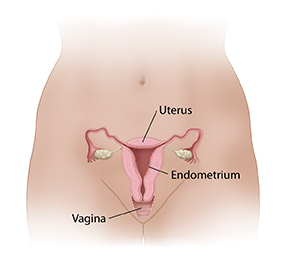What Is Endometrial Cancer?
Cancer usually starts when normal cells in the body change (mutate). They start growing (replicating) out of control. Cancer cells can form lumps of tissue. They are called tumors. Cancer that starts in the lining of the uterus is called endometrial cancer.

Understanding the uterus and endometrium
The uterus is part of the female reproductive system. It's the organ that holds the baby during pregnancy. The endometrium is the inside lining of the uterus. Each month, from puberty to menopause, the lining grows and gets thicker. This is to get ready for pregnancy. This thickened lining helps to nourish a growing baby. The lining of the uterus is shed if a person doesn’t become pregnant. This is their period. Endometrial cancer starts in the cells of this lining.
When endometrial cancer forms
The endometrium is the most common place in the uterus for cancer to start. It's the most common type of cancer of the female reproductive system. Like most cancers, endometrial cancer can spread. It can spread within the uterus. It can also spread to nearby organs and other parts of the body. It's called metastasis when cancer spreads outside the uterus. The more cancer spreads, the harder it is to treat.
The most common symptom of endometrial cancer is abnormal vaginal bleeding. Or it's vaginal bleeding after menopause called postmenopausal bleeding. Abnormal vaginal bleeding has no cycle to it like menstruation does. Call your health care provider if you have unexpected vaginal bleeding. Ideally, endometrial cancer is found when it's small and has not spread (metastasized). This is when the cancer is easiest to treat. It is also easiest to cure.
Treatment choices for cancer of the uterus
You and your health care provider will talk about your treatment choices. They may include:
-
Surgery to remove the uterus (hysterectomy). Most commonly, the fallopian tubes and ovaries are removed. Nearby lymph nodes may also be taken out.
-
Radiation therapy. This treatment uses focused beams of high energy to kill cancer cells.
-
Chemotherapy. This treatment uses strong medicines to kill cancer cells.
-
Hormone therapy. This treatment affects hormone levels. It may help slow the growth of cancer cells. It may be used in some cases to prevent the need for hysterectomy. This allows for pregnancy in the future.
-
Targeted therapy. This treatment uses medicines that target the abnormal changes in the cancer cells.
-
Immunotherapy. This treatment uses medicines that help your body's own immune system better fight cancer.
Online Medical Reviewer:
Howard Goodman MD
Online Medical Reviewer:
Jessica Gotwals RN BSN MPH
Online Medical Reviewer:
Susan K. Dempsey-Walls RN
Date Last Reviewed:
4/1/2025
© 2000-2025 The StayWell Company, LLC. All rights reserved. This information is not intended as a substitute for professional medical care. Always follow your healthcare professional's instructions.